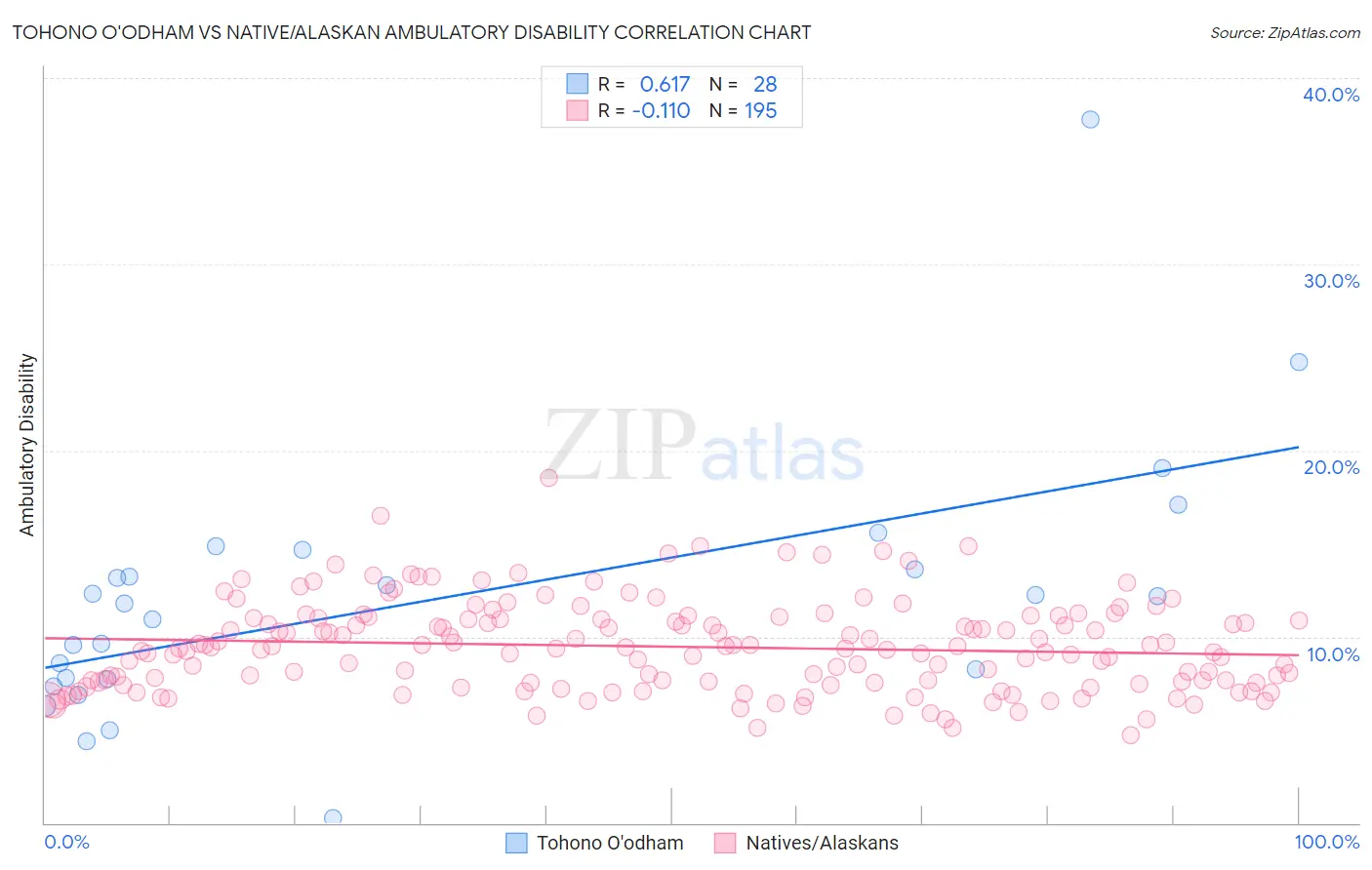Tohono O'odham vs Native/Alaskan Ambulatory Disability
COMPARE
Tohono O'odham
Native/Alaskan
Ambulatory Disability
Ambulatory Disability Comparison
Tohono O'odham
Natives/Alaskans
8.7%
AMBULATORY DISABILITY
0.0/ 100
METRIC RATING
343rd/ 347
METRIC RANK
7.5%
AMBULATORY DISABILITY
0.0/ 100
METRIC RATING
327th/ 347
METRIC RANK
Tohono O'odham vs Native/Alaskan Ambulatory Disability Correlation Chart
The statistical analysis conducted on geographies consisting of 58,714,537 people shows a significant positive correlation between the proportion of Tohono O'odham and percentage of population with ambulatory disability in the United States with a correlation coefficient (R) of 0.617 and weighted average of 8.7%. Similarly, the statistical analysis conducted on geographies consisting of 512,715,386 people shows a poor negative correlation between the proportion of Natives/Alaskans and percentage of population with ambulatory disability in the United States with a correlation coefficient (R) of -0.110 and weighted average of 7.5%, a difference of 16.1%.

Ambulatory Disability Correlation Summary
| Measurement | Tohono O'odham | Native/Alaskan |
| Minimum | 0.26% | 4.7% |
| Maximum | 37.8% | 18.5% |
| Range | 37.5% | 13.8% |
| Mean | 12.1% | 9.5% |
| Median | 12.0% | 9.4% |
| Interquartile 25% (IQ1) | 7.8% | 7.5% |
| Interquartile 75% (IQ3) | 14.2% | 11.0% |
| Interquartile Range (IQR) | 6.4% | 3.5% |
| Standard Deviation (Sample) | 7.0% | 2.4% |
| Standard Deviation (Population) | 6.9% | 2.4% |
Demographics Similar to Tohono O'odham and Natives/Alaskans by Ambulatory Disability
In terms of ambulatory disability, the demographic groups most similar to Tohono O'odham are Tsimshian (8.8%, a difference of 0.97%), Kiowa (8.6%, a difference of 1.5%), Puerto Rican (8.9%, a difference of 1.6%), Creek (8.5%, a difference of 3.4%), and Choctaw (8.3%, a difference of 5.1%). Similarly, the demographic groups most similar to Natives/Alaskans are Black/African American (7.5%, a difference of 0.010%), Comanche (7.5%, a difference of 0.12%), Hopi (7.6%, a difference of 0.94%), Pueblo (7.6%, a difference of 0.98%), and Paiute (7.7%, a difference of 2.2%).
| Demographics | Rating | Rank | Ambulatory Disability |
| Comanche | 0.0 /100 | #325 | Tragic 7.5% |
| Blacks/African Americans | 0.0 /100 | #326 | Tragic 7.5% |
| Natives/Alaskans | 0.0 /100 | #327 | Tragic 7.5% |
| Hopi | 0.0 /100 | #328 | Tragic 7.6% |
| Pueblo | 0.0 /100 | #329 | Tragic 7.6% |
| Paiute | 0.0 /100 | #330 | Tragic 7.7% |
| Cajuns | 0.0 /100 | #331 | Tragic 7.8% |
| Menominee | 0.0 /100 | #332 | Tragic 7.8% |
| Cherokee | 0.0 /100 | #333 | Tragic 7.9% |
| Yuman | 0.0 /100 | #334 | Tragic 7.9% |
| Chickasaw | 0.0 /100 | #335 | Tragic 8.0% |
| Seminole | 0.0 /100 | #336 | Tragic 8.0% |
| Dutch West Indians | 0.0 /100 | #337 | Tragic 8.2% |
| Colville | 0.0 /100 | #338 | Tragic 8.2% |
| Pima | 0.0 /100 | #339 | Tragic 8.2% |
| Choctaw | 0.0 /100 | #340 | Tragic 8.3% |
| Creek | 0.0 /100 | #341 | Tragic 8.5% |
| Kiowa | 0.0 /100 | #342 | Tragic 8.6% |
| Tohono O'odham | 0.0 /100 | #343 | Tragic 8.7% |
| Tsimshian | 0.0 /100 | #344 | Tragic 8.8% |
| Puerto Ricans | 0.0 /100 | #345 | Tragic 8.9% |